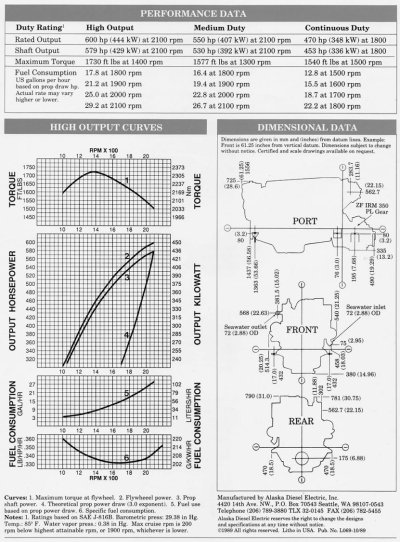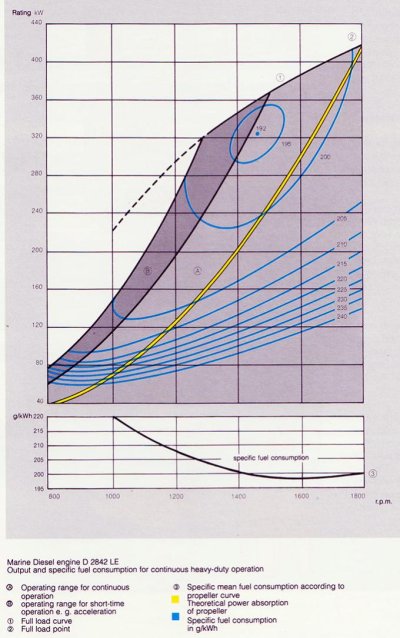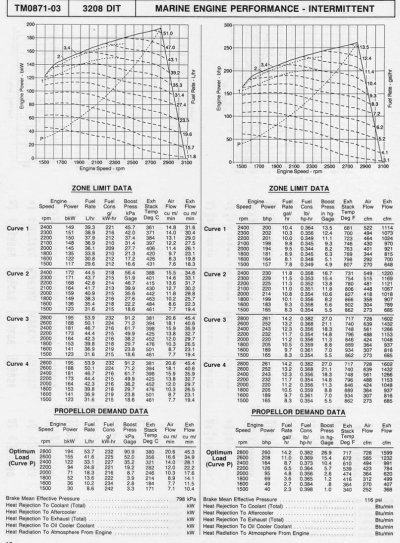Nomad Willy
Guru
I agree w Fred except the "cruising prop" thing.
Last edited:
Isn't it a common trait among designers to state a boats cruising speed as being a wee bit under hull speed, yet give the boats range somewhere around half throttle? The numbers never really add up...
Take a builder's range claims with a grain of salt. Seahorse Marine's website says the 14-ton Coot has a range variously of 1400 and 1800 nautical miles for 390 gallons at 7 knots (fraction of a knot less than hull speed). Nevertheless, to go 7 knots requires over 2000 RPM from the JD4045. This equates to a theoretical range (without reserve) of about 1200 miles.
Regardless, my Coot has a fuel capacity of just 318 gallons, for a theoretical range of 980 miles at 7 knots. At half throttle (1600 RPM), the theoretical range is 1400 miles moving nearly 6 knots an hour.
Take a builder's range claims with a grain of salt. Seahorse Marine's website says the 14-ton Coot has a range variously of 1400 and 1800 nautical miles for 390 gallons at 7 knots (fraction of a knot less than hull speed). Nevertheless, to go 7 knots requires over 2000 RPM from the JD4045. This equates to a theoretical range (without reserve) of about 1200 miles.
Some of the HP hype in boats actually come from the engine manufacturer. A builder is buying reliable 240 HP diesels for a few years and suddenly the 315HP version becomes the same price as the 240, and the next year the 240 is no longer available. Eventually, they engineer a smaller block to get 240 HP, and voila, you've got your 240 HP back again, but in a block that is much higher stressed than the old reliable block you used to have. In truck engines, this goes on and on and on, and ultimately, one ends up with something like a 425 HP 3208 Cat, and the limited life that goes with it. The impulsiveness of the retiring baby-boomers, whom rather hear the number 315 than they would 240, will likely keep it that way for the foreseeable future.
Is it safe to assume that between two identical 'tugs' the 210HP version will have a lower fuel burn at a given speed than the newer 330HP version?

TAD has posted the usual almost useless graphs pushed by the engine folks.
If you check at the bottom of the posted table, you'll see that curve #5 is "Fuel use based on prop power draw". Not on fully loaded engine.Its useful for full throttle operation , after that its all math speculation concerning prop hp ,loading and fuel burn..
The problem is the fuel burn curves are for a fully loaded engine at that operating RPM.
Not impossible....but there's some creative graphics going on with them as well, here's one from MAN and from CAT. They are quite different looking.Called a fuel map , they are almost impossible to obtain .


I recall that most engines that are found in our old trawlers are most efficient at about 1800rpm or so. Bottom line is that if you run close to full bore you bay a penalty and if you run less than a 50 to 70% load you burn pay even a larger penalty.
I like TAD's comment about weight. A twin engined 36GB running the way most do now (underloaded) you pay two rather large penalties. You've got twice as much power as the single engined boat so running slow (7.5 knots) both engines are at about 25 to 30% load. Far far away from the most efficient speed and load for best efficiency. The single engined boat would run under a load of about 55%. Much better. If propped right that would be (a guess here) about 1900 to 2000rpm.
Also the 2nd engine and all that it has for support equipment weighs over a ton. We frequently talk about the power requirement for a displacement boat as "X # of tons per hp" The only variable there is weight. Hmmmmm Must have a very significant effect on the amount of power required to drive a given hull.
So there is one significant and one large reason that the single engined boat will be more efficient. Of course if the twin engined boat was to have one engine twice the power of the single it would be not far from the same.
Not just the added weight penalty, there's additional drag from the extra shaft, struts, prop, and rudder.
And then.....for the fellow who needs a "Dooms Day Boat"....There's Favonius....complete with twin get home engines and 4000 usg of fuel......
Wolfe Marine Sales, Inc. (Seattle, WA)
And then.....for the fellow who needs a "Dooms Day Boat"....There's Favonius....complete with twin get home engines and 4000 usg of fuel......
Wolfe Marine Sales, Inc. (Seattle, WA)
I recall that most engines that are found in our old trawlers are most efficient at about 1800rpm or so. Bottom line is that if you run close to full bore you bay a penalty and if you run less than a 50 to 70% load you burn pay even a larger penalty.
Peter what is it? I have no problems w the windows.
Someone interested in a Doomsday boat will probably give up the big glass high water view motor boat and purchase and aux sail or motor sail.
Doomsday will be world wide , not simply the collapse of one country , so fuel which requires great international trade co operation may be difficult to obtain.
Wind is FREE , and Ocean Passages for the World show the sail routes in great detail.
A custom crunch boat would be set up to survive in the old way,
wood range, sun covers and excellent ventilation , large water tanks with rain catch refill ability.
Amen! As I stated previously, the mental gymnastics that have been posted on the engine efficiency subject don't mean much (if anything) to the recreational boater. There are so many other subjects that affect safety, comfort and cost that are relative to our boats.Your time might be better spent in finding a way to move a reasonable load between A and B in the time you allot and in the most comfortable manner at a cost you are happy to accept. I don't think you will accomplish that by trying to micro-analyze engine efficiency.

